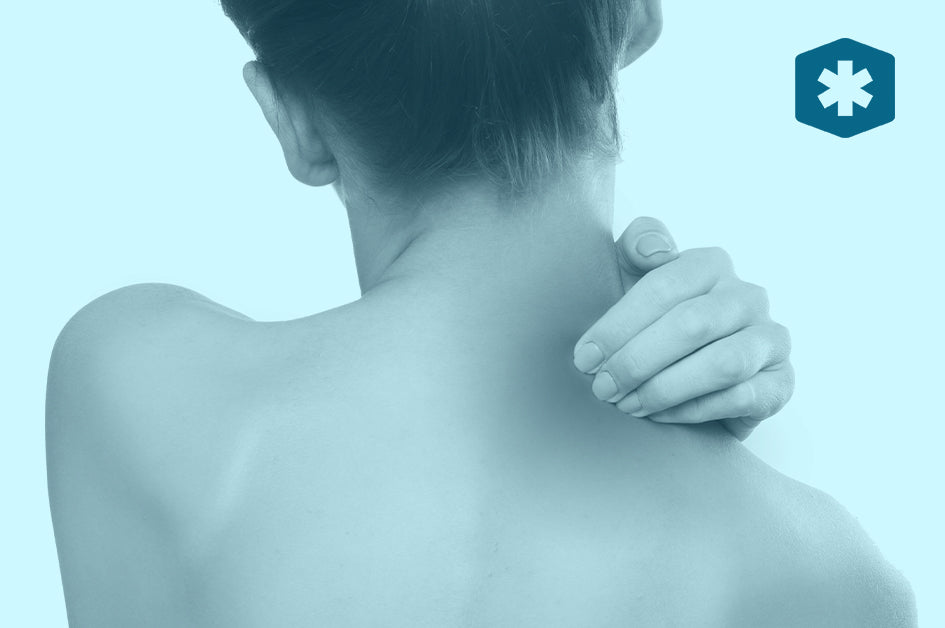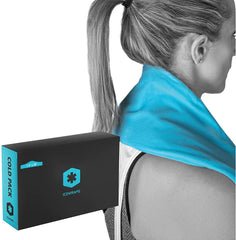Your Cart is Empty

Contents
You and I could have something in common -- we both could be nursing a neck problem right now. We’re likely not alone, because according to a study done by Childs, neck injuries are common.
The study shows that 10% to 20% of the population reported having neck problems, with 54% of people experiencing neck pain within the last 6 months. It's also estimated that 22% to 70% of the population will have neck pain some time in their lives.
We know that your neck is an important part of the body, so we’ve taken the liberty to help you recognize some of the most common neck injuries and how you can treat them.
Who said managing neck pain had to be a pain in the neck?
Composing your neck are many complex parts. By understanding the anatomy of the neck, you’ll be able to understand how injuries to the neck can occur.
The bones of the neck, also called the cervical spine, consist of seven bones or vertebrae (C1 to C7). These bones stack on top of each other and allow the neck to rotate and move in different directions.

Cushioned between these vertebrae are structures called the cervical discs. They act as shock absorbers for the neck and allow them to bend, twist, and resist compression forces.
Along the cervical bones lie a network of nerves and blood vessels that resemble wires powering the appliances you have at home. This makes the area prone to cervical injuries that compress the nerves or blood vessels.
The neck is also divided into triangles, with each one containing specific muscles, vessels, and nerves. Most of the neck muscles connect the head to the torso. These muscles are responsible for movements such as nodding the head, bending the head to the sides and rotating the head.
Now that we have an overview of the parts of the neck, let’s dive into the most common neck injuries.
Sprains and strains are common neck injuries that occur during sudden, jarring motions. Sprains happen when the ligaments in the neck stretch beyond their capacity, while strains occur when the neck muscles or tendons tear. This is a common cause of neck pain in many people.
These are some of the symptoms that can occur with a neck sprain or strain:
Watch this video to get a more detailed overview of what neck sprains and strains are.
Neck sprains or strains will heal if treated the right way. Your doctor may recommend you wear a brace or a soft collar to support and help relieve pressure on the ligaments and muscles in the neck.
There’s an array of medications available over the counter that can help relieve pain. Ask your doctor about what medications are best to take if your neck pain becomes unbearable.
In conjunction with taking pain medications, it’s a good idea to apply an ice pack as an additional remedy for neck pain.
You should use cold therapy for the first 24 to 48 hours after the onset of the injury. After that period, you can switch over to hot therapy, or you can alternate both hot and cold applications.
You can find what you need to ease your pain here at IceWraps.com, where ice and hot packs for pain relief are available at a click of a button.
 |
| ICEWRAPS COLD THERAPY CLAY PACK WITH COVER |
Sprains or strains usually heal on their own but seeing a physical therapist is never a bad idea. Your therapist can give you neck stretches for your neck pain as well as help you strengthen your muscles. They can also correct your posture and give good tips like what the best pillow for neck pain is.
They can give you a home exercise routine so you’d be able to exercise without stepping out of your front door.
How awesome is that?
This video will teach you neck pain remedies that you can do at home to relieve your neck pain. These techniques also strengthen your neck muscles which helps your posture.
With enough rest and the right treatment, most people recover from a neck sprain or strain within four to six weeks,while more serious neck injuries could take over a few months to heal.
The discs that are between each vertebra have a gel-like substance at the center. Making up the outer part of the disc are cartilaginous fibers that keep the gel in place.
A herniated disc occurs when the outer part containing the gel tears or ruptures, causing the gel to bulge out. Think of yourself squeezing a burger together to fit in your mouth before you bite into it. You squeezing it makes the patty, along with all its contents, bulge out and fall off. That’s similar to what happens in a herniation.
This bulge then compresses the nerve root or spinal cord, injures the neck, and causes symptoms such as neck pain or numbness.
A herniated disc is also called a “ruptured disc” or a “slipped disc”, and is one of the most common neck injuries.
If the disc presses on a nerve root, symptoms may include:
If the disc presses on your spinal cord, however, more serious symptoms can occur such as:
If you want a visual explanation of what goes on in a herniation, watch this video as it thoroughly explains how a cervical herniated disc happens.
The usual treatment for a mild herniated disc can include conservative treatments like taking medications, applying ice or hot packs, and getting the proper rest.
Here at IceWraps.com, we have ice packs that fit comfortably on your neck like our extra-large neck ice pack. If you're looking for pain relief, this ice pack is sure to do the trick.
While applying an ice pack, you should also change the way you do specific activities to prevent the pain from worsening. This can include avoiding or at least minimizing, movements that can make the pain worse.
Having a physical therapist evaluate your neck pain to get the proper treatment will ensure that your condition heals as fast as possible.
Surgery is an option for individuals with more serious symptoms such as neurological deficits. It's important to have a medical professional evaluate your symptoms to rule out conditions such as a spinal cord injury.
Cervical degenerative disc disease happens when the disc of your cervical spine goes through the normal changes associated with aging. Although degenerative disc disease may cause a herniated disc, it’s a completely different neck injury.
As we mentioned, the cervical discs are like shock absorbers that support the neck during movements. When you’re born, water is what makes up most of the cervical disc. As you age, the disc loses water and can break down, causing pain in your neck.
Symptoms of degenerative disc disease may vary depending on the location of the weak disc and how much of a change the disc has gone through.
Some of the common symptoms of this can include:
Watch this video to get a better understanding of what cervical degenerative diseases are and how they occur.
Due to the constant bone-to-bone rubbing, pain and inflammation can be present at the site, which could disrupt your everyday activities. To treat neck pain, your doctor may recommend pain medications and ice pack application to the painful site.
Resting and activity modifications are vital as well. If you spend most of your day sitting down, then it would be a good idea to invest in a chair with proper neck and back support.
Be mindful of your posture and sleeping position, as poor posture may cause your symptoms to worsen.
In addition to that, undergoing physical therapy will help strengthen the muscles of your neck, improving support and stability for your neck.
Osteoarthritis, also known as cervical spondylosis, is another common neck injury that involves changes to the bones, cartilages, and joints. The cause of these changes is due to the normal wear and tear that happens as we age.
As you age, the cartilage between your joints begins to wear away. Once the cartilage wears away, the bone starts rubbing on the bone. This can cause the bone to deform and form abnormal growths called osteophytes.
The symptoms of cervical osteoarthritis include:
This video breaks down what cervical osteoarthritis is and how it can occur. The images used in the video will help you understand this condition better.
Unfortunately, there’s no way to stop bones from degenerating as we grow older. If only we can stop the aging process, right? Wouldn't that be a big help!
Despite this, you’ll still be able to manage your symptoms to slow down the degenerating process.
Your doctor may prescribe you medications to reduce your neck pain. While on pain medications, getting the proper rest will be important. You’ll most likely have to stop certain activities that make your neck pain worse, or you’ll have to figure out a way to modify those activities to minimize or eliminate your neck pain.
Aside from that, surgical treatments are also available in cases where symptoms are more serious.
Also known as a broken neck, a fractured cervical spine occurs when a break in the cervical vertebra is present.
Fractures usually result from high-energy trauma, such as car accidents or falls. Neck fractures resulting from ground-level falls such as falling off a chair are common among the elderly population.
Symptoms of a fractured cervical spine will depend on the severity of the fracture. These symptoms can range from localized pain to neurological symptoms.
Among the symptoms of a fractured cervical spine are:
The treatment for a neck fracture will depend on the location of the fracture, how severe it is, and what type of fracture it is. There are two routes you can go: the conservative (non-operative) and the invasive (operative) route.
Some minor fractures can heal on their own in weeks or months with the right treatment, pain medications, and rest. While more serious fractures will need surgery to fix the affected bones.
Wearing a neck brace will be ideal for mild compression fractures. This can help support the neck and prevent excessive movement. It also serves as a nice fashion statement.
If you opted for surgery, you’ll need physical rehabilitation for at least a few weeks. Your therapist can give you post-surgery exercises to strengthen your neck muscles and keep them from shrinking.
Your therapist may also use heat or cold therapy in conjunction with doing exercises. This would be a safe way to reduce your neck pain or stiffness that comes after undergoing surgery.
There you have it – the 5 most common neck injuries!
We hope you’re not up to your neck with all this information.
As we mentioned in this article, there are many options that you can choose from when it comes to finding the right pain relief for your neck injury.
These solutions can be conservative or invasive, depending on the severity of your injury.
Always remember that a healthy diet with regular exercise will also be beneficial to your recovery.

With the right treatment, rest, and medical consultation, you’ll be able to recover from these common neck injuries in no time.
The importance of heat and cold therapy in the recovery of neck injuries is self-evident. Cold therapy should be used for newer injuries, whereas hot therapy should be used for older and more chronic injuries.
We have a range of gel and clay packs at IceWraps.com that will meet your needs. We have ice packs that wrap securely over your neck as well as packs that cover your entire lower back to maximize pain relief.
With IceWraps.com, pain relief is only a click away!
Comments will be approved before showing up.